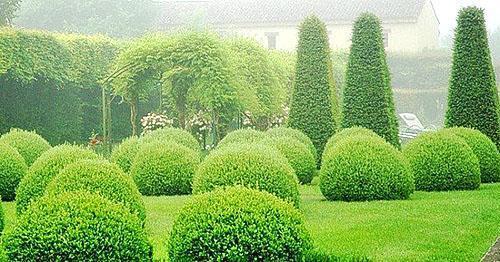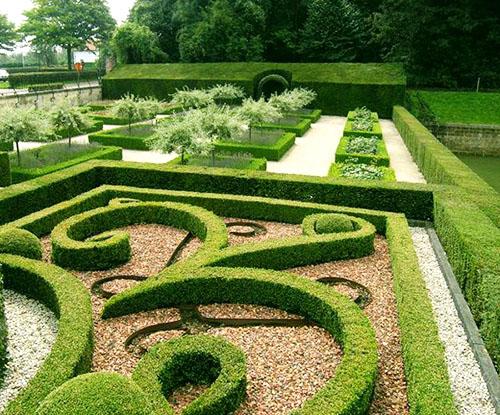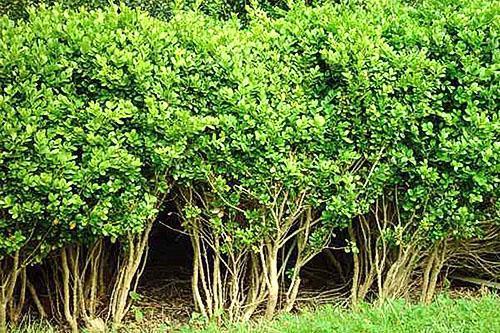Planting and caring for boxwood evergreen at home
 Boxwood (other names - beech, busk, stone tree) is a beautiful evergreen shrub with very hard wood that can decorate any landscape.
Boxwood (other names - beech, busk, stone tree) is a beautiful evergreen shrub with very hard wood that can decorate any landscape.
This pliable plant tolerates frequent shaping haircuts with ease. In landscape design, boxwood plantings are used to form living fences and curbs, plant it as solo specimens on lawns, and "sculpt" green sculptural compositions - topiary. Various volumetric geometric shapes - cubes, pyramids, balls - are formed from it, they create intricate labyrinths.

 In nature, boxwood grows, depending on the species, from 2 to 14 meters in height. It is found in tree and shrub form. In the wild, it can be found in the southern part of the African continent, Central America, southern Europe, Asia Minor, Oceania and Japan.
In nature, boxwood grows, depending on the species, from 2 to 14 meters in height. It is found in tree and shrub form. In the wild, it can be found in the southern part of the African continent, Central America, southern Europe, Asia Minor, Oceania and Japan.
We will talk about varieties, botanical features, planting and caring for box trees below.
Boxwood varieties
 The plant has about 30 species and is classified as poisonous. In this case, boxwood also has medicinal antibacterial properties. It contains phytoncides that kill many disease-causing bacteria. The flowers of the boxwood are small, inconspicuous, have no decorative value. The fruit is a hard, three-lobed capsule containing small black seeds.
The plant has about 30 species and is classified as poisonous. In this case, boxwood also has medicinal antibacterial properties. It contains phytoncides that kill many disease-causing bacteria. The flowers of the boxwood are small, inconspicuous, have no decorative value. The fruit is a hard, three-lobed capsule containing small black seeds.
If you have small children in your house, then, given the toxicity of boxwood, you better refrain from planting it in an apartment or on a plot.
 Evergreen boxwood (Buxus sempervirens) is mainly used for decorative gardening. On its basis, several variegated varieties have been bred, alternating green leaves with white and shades of yellow. However, it should be noted that the higher decorativeness of these plants reduced their winter hardiness.
Evergreen boxwood (Buxus sempervirens) is mainly used for decorative gardening. On its basis, several variegated varieties have been bred, alternating green leaves with white and shades of yellow. However, it should be noted that the higher decorativeness of these plants reduced their winter hardiness.
 Different types of buxus differ significantly in height, growth rate, crown color. Therefore, in landscape design, varieties for planting are selected taking into account their purpose:
Different types of buxus differ significantly in height, growth rate, crown color. Therefore, in landscape design, varieties for planting are selected taking into account their purpose:
- For short hedges and curbs, the slow-growing Blauer Heinz and Suffruticosa varieties are ideal. Curb plants are planted in a row at a distance of 30-40 cm from each other.
- For small garden forms, as well as container plants, single plantings of varieties are used, for example, "Green Gem" or "Suffruticosa".
- For large green sculptures, it is better to use group plantings, 2-5 plants of tall varieties. Common evergreen boxwood is best suited for this purpose.
 Other varieties of buksus are less common, but, nevertheless, they are also successfully used in decorative gardening and landscape design. The farther north the growing area is, the more winter-hardy varieties should be used for planting outdoors. Today, the most winter-hardy varieties are considered:
Other varieties of buksus are less common, but, nevertheless, they are also successfully used in decorative gardening and landscape design. The farther north the growing area is, the more winter-hardy varieties should be used for planting outdoors. Today, the most winter-hardy varieties are considered:
- Buxus Sempervirens;
- Handsworthiensis;
- Blauer Heinz;
- Herrenhausen
- Rotundifolia
It should also be mentioned that boxwood is an ideal plant for making bonsai.Small leaves and slow growth make it possible to create true miniature masterpieces under appropriate conditions. The most suitable cultivar for bonsai is Buxus harlandii Hance.
Soil for planting boxwood
To plant boxwood, the soil must be:
- loamy;
- with neutral acidity;
- nutritious;
- loose and breathable;
- well drained.
On such soils, boxwood plants grow strong, densely leafy, shiny. Boxwood can grow on poor soils, but then its crown growth will slow down, although it will still remain dense and dense.
In the area where the boxwood grows, in no case should water stagnate - the plant cannot stand this at all. Also, heavy and acidic soils are not suitable for box trees. On poor sandy soils under the boxwood, it is necessary to add a mature compost and slaked lime.
 If the conditions of the site do not allow you to plant boxwood in open ground, then you can successfully cultivate it in containers, digging them into the ground in the right places. Plants can hibernate in the same containers. Young plants should also be kept in containers for the first 2-3 years before planting in a permanent place.
If the conditions of the site do not allow you to plant boxwood in open ground, then you can successfully cultivate it in containers, digging them into the ground in the right places. Plants can hibernate in the same containers. Young plants should also be kept in containers for the first 2-3 years before planting in a permanent place.
Planting boxwood
 Planting boxwood in open ground is best done in spring, with the onset of stable heat. Such a margin of time is necessary for plants to form a branched root system. The better the roots of the seedlings develop, the more chances they will have to successfully survive the first winter outdoors.
Planting boxwood in open ground is best done in spring, with the onset of stable heat. Such a margin of time is necessary for plants to form a branched root system. The better the roots of the seedlings develop, the more chances they will have to successfully survive the first winter outdoors.
If you need to transplant adult plants, then this can be done throughout the warm season. IMPORTANT! Mature boxwood plants are not very fond of transplanting. Therefore, when digging up a plant, you need to take it out with a large enough clod of soil to minimize damage to the roots. It is best to allow the boxwood to grow in a permanent location, replacing only the top layer of soil below it. This will provide the plant with an influx of new food.
 For planting boxwood, pits should be prepared that exceed the volume of the root system of each specimen twice - in depth and in width. Half of the pit volume is filled with a substrate of coarse sand, leaf humus and sod land (1: 4: 2). Potassium fertilizer can be added to the substrate, and then pour abundantly with water. After that, a seedling is carefully placed in the hole, spreading the roots, and falling asleep, compacting, the rest of the substrate.
For planting boxwood, pits should be prepared that exceed the volume of the root system of each specimen twice - in depth and in width. Half of the pit volume is filled with a substrate of coarse sand, leaf humus and sod land (1: 4: 2). Potassium fertilizer can be added to the substrate, and then pour abundantly with water. After that, a seedling is carefully placed in the hole, spreading the roots, and falling asleep, compacting, the rest of the substrate.
Boxwood care
 Boxwood - "southerner". It easily tolerates the summer sun. But bright spring rays can destroy him.
Boxwood - "southerner". It easily tolerates the summer sun. But bright spring rays can destroy him.
Spring sunburn, as well as freezing of leaves as a result of frosty clear weather and cold winds can lead to the death of the aerial part of the plant. To prevent this from happening, you should take care of the safety of your landings in advance.
 Depending on the shape and size of boxwood plants, you should use different methods of insulating them:
Depending on the shape and size of boxwood plants, you should use different methods of insulating them:
- Low border plantings can be covered for the winter with special nets, non-woven insulation or even burlap. In this case, all covering devices must be reliably strengthened so that the snow covering them does not break off the branches.
- Small single molds can be covered with plywood boxes with ventilation holes.
- Plants on the trunk should be tied with strong supports and wrapped with coniferous spruce branches.
- Large garden molds can be wrapped in wide sheets of nonwoven fabric in several layers.
With the onset of spring heat, all shelters from boxwood plantings are immediately removed. If this is not done, then the plants may vanish.
Such protective measures have worked well, but they are not always convenient. In this case, one very useful property comes to the rescue, which is successfully used when planting and caring for boxwood. This plant is shade-tolerant, sometimes even shade-loving.Therefore, boxwood stands should be placed under the cover of buildings, structures or large trees, thereby protecting them from scorching sunlight and icy winds. Best of all, boxwood feels in carved partial shade, or in an area open to the sun for only one part of the day.
Seasonal care of boxwood consists of mulching the soil around the plants with peat or humus, as well as regular watering. Since boxwood is moisture-loving, the soil around it should be kept slightly moist, preventing the top layer from drying out. Plants can also be sprayed with an aerator to moisturize foliage. In winter, watering should be reduced.
Also, caring for boxwood includes preparing plants for wintering. At the end of autumn, before the onset of stable cold weather, planting boxwood should be watered abundantly in order to create a supply of moisture for the plants. After that, the soil around them must be mulched. peat or pine needles. Do not use fallen leaves for mulching. Foliage that has matured over the winter in spring can disrupt air circulation in the soil and rotting threatens the roots of the buxus. This preparation of boxwood plantings for winter allows you to keep the roots warm and moisture in evergreen foliage.
If the plant is grown in a container culture, then at the age of 2-3 years it can already be left to winter outside by placing the pot with the plant not directly in the ground, but in a large dug-in container filled with peat or sawdust. The soil under the plant is mulched, and the plant itself is covered.
You need to feed the buxus 3-4 times during the summer, using complex mineral or organic fertilizers.
An important point in caring for boxwood plants is cutting it. It is usually produced 2-3 times a year, giving the overgrown plantings the required shape.
There are not many pests in boxwood, since the plant contains poisonous alkaloids that repel insects from it. Boxwood can be damaged:
- fly Monarthropalpus;
- spider mite;
- boxwood felt;
- fungal diseases.
 In order to prevent damage when pruning boxwood plants, you must carefully remove all dried and wilted twigs, and also treat the plantings with insecticide solutions.
In order to prevent damage when pruning boxwood plants, you must carefully remove all dried and wilted twigs, and also treat the plantings with insecticide solutions.
The boxwood is propagated by seed and vegetatively. The second method is preferable, since boxwood seeds do not have a very high germination capacity. Green cuttings, on the other hand, have a very high degree of rooting, and each haircut gives an abundance of propagation material. In addition to rooting cuttings, rooting of young cuttings can be used.
Caring for boxwood at home
 Buscus has long been grown as an indoor crop. However, caring for boxwood at home has its own characteristics that have created a reputation for it as a capricious plant.
Buscus has long been grown as an indoor crop. However, caring for boxwood at home has its own characteristics that have created a reputation for it as a capricious plant.
A window sill for a boxwood should be chosen east or west, or even place it next to the window on a separate stand. If the boxwood plant is to live on the south window, then it is necessary to provide for shading from the midday sun.
To prevent your pet from shedding its leaves, it is important to strictly follow the watering and moisturizing regime.
In no case should water accumulate in the pallet - this can easily cause rotting of the root system of the axle box.
 The plant should be watered a little every day, as well as sprayed from the aerator. In the autumn-winter period, watering is reduced to a minimum. Boxwood should overwinter at a temperature of 6-10 ° C. You can place it between window frames in apartments with an old layout. With modern plastic windows, a boxwood plant for wintering can be settled on the floor by a glazed balcony door.
The plant should be watered a little every day, as well as sprayed from the aerator. In the autumn-winter period, watering is reduced to a minimum. Boxwood should overwinter at a temperature of 6-10 ° C. You can place it between window frames in apartments with an old layout. With modern plastic windows, a boxwood plant for wintering can be settled on the floor by a glazed balcony door.
Boxwood can only be transplanted by transshipment. Since it grows extremely slowly, it is recommended to transplant it every 2-3 years. You can trim the indoor buxus all year round.
 If you are growing bonsai, remember that the boxwood specimen does not need replanting. If the roots are damaged, the plant can simply shed its foliage.
If you are growing bonsai, remember that the boxwood specimen does not need replanting. If the roots are damaged, the plant can simply shed its foliage.
If these are not so complicated rules for caring for boxwood at home, then this plant will delight you for many years with its inexhaustible energy and beauty.
Super!!! Very complete information. Simple and straightforward. Thank!!